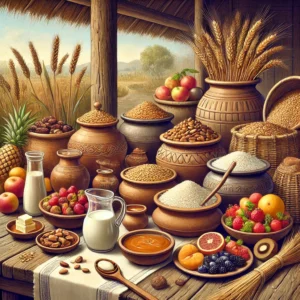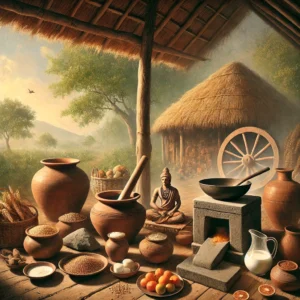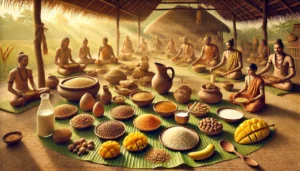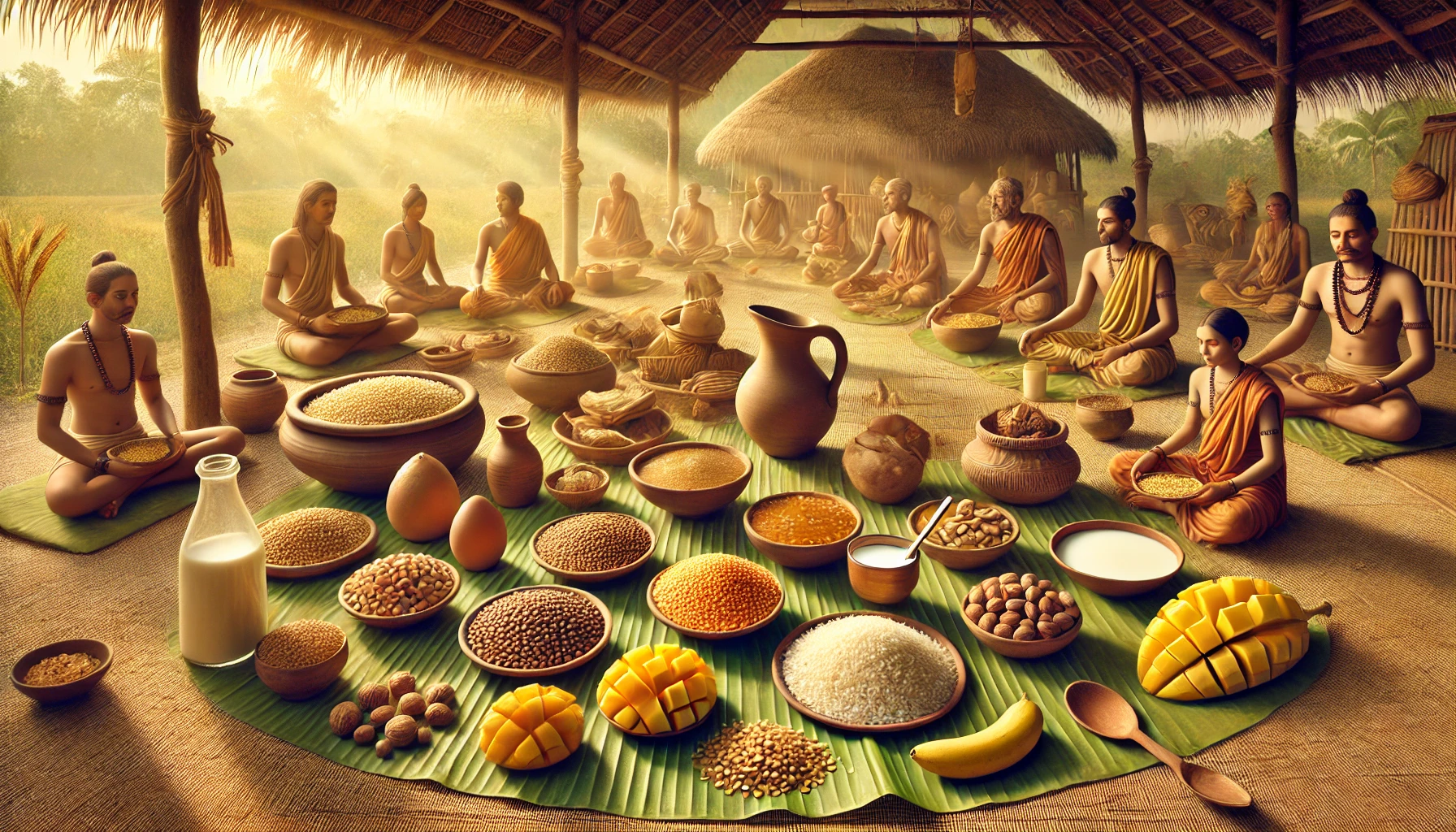
How to recreate Vedic-era recipes today
Food in the Vedic Era: What Our Ancestors Ate
The Vedic era, which spanned roughly from 1500 BCE to 500 BCE, marked the dawn of Indian civilization. It was a time of rich cultural, spiritual, and intellectual evolution, with food playing a central role in the daily lives and rituals of the people. Unlike the industrialized and commercialized food systems of today, Vedic-era dietary practices were rooted in sustainability, reverence for nature, and an understanding of the body-mind-soul connection. Food was seen not just as nourishment but as a sacred gift from the divine, a medium to maintain health and achieve spiritual growth.
Drawing upon insights from ancient texts like the Vedas, Upanishads, and Ayurveda, this article explores the ingredients, culinary practices, and dishes of the Vedic era, offering a glimpse into the dietary wisdom of our ancestors.
Ingredients of the Vedic Era
The ingredients of the Vedic diet were natural, unprocessed, and predominantly plant-based, emphasizing balance, health, and harmony with nature. Here are the primary food groups:
Grains and Cereals
Barley (Yava):
Barley was one of the earliest domesticated grains and a staple in Vedic cuisine. It was used to prepare porridge, flatbreads, and ritualistic offerings.
Barley was also considered sacred and was central to yajnas (sacrificial rituals).
Rice (Vrihi):
While barley was more common in early Vedic times, rice gained prominence later.
Rice was often cooked with milk and ghee to create offerings such as Charu and Payasam.
Millets:
Millets like Ragi, Kodo, and Jowar were cultivated and consumed, especially in regions with arid climates.
Wheat:
Though less mentioned in the Rigveda, wheat became a significant cereal in the later Vedic period, used to prepare breads and cakes.
Table of Contents
Pulses and Legumes
Masha (Urad Dal) and Mudga (Moong Dal):
Pulses were an essential protein source for vegetarians.
Moong dal, in particular, was considered light and sattvic, suitable for fasting and rituals.
Chana (Chickpeas) and Masura (Red Lentils):
These lentils were cooked with minimal spices or added to soups and stews.

How to recreate Vedic-era recipes today
Dairy Products
Milk and Ghee:
Cows were highly revered, and milk was considered a divine elixir.
Ghee, or clarified butter, was central to Vedic life—used in cooking, medicine, and yajnas.
Curd and Buttermilk:
Fermented dairy products were prized for their digestive and cooling properties.
Paneer:
Though not identical to modern paneer, the coagulation of milk to produce soft cheese-like products was practiced.
Fruits and Vegetables
Fruits like mangoes, bananas, pomegranates, jujube (ber), and amla (Indian gooseberry) were consumed fresh or dried.
Vegetables such as gourds, yams, radishes, and cucumbers were part of the daily diet.
Spices and Herbs
Spices such as turmeric, ginger, black pepper, and cumin were used sparingly for flavor and medicinal purposes.
Holy basil (Tulsi) and other Ayurvedic herbs were integral to food and medicine.
Sweeteners
Madhu (Honey): Used both as a sweetener and in medicinal preparations.
Guda (Jaggery): A natural sugar substitute made from sugarcane juice or palm sap.

How to recreate Vedic-era recipes today
Culinary Practices of the Vedic Era
Food preparation in the Vedic era was governed by principles of cleanliness, simplicity, and sanctity. It was believed that the cook’s mental state influenced the energy of the food, making mindfulness an essential part of cooking.
Cooking Techniques
Boiling and Roasting:
Grains, lentils, and vegetables were boiled or roasted, often over an open fire.
Fermentation:
Fermented foods like curd, buttermilk, and sour rice preparations were common.
Grilling and Frying:
Grilled meats and fried sweets like Apupa (barley pancakes) were prepared during festivals or special occasions.
Stone Grinding:
Herbs and spices were ground using stone mortars to preserve their natural flavors.
Ritual Foods
Food played a central role in Vedic rituals, symbolizing prosperity, gratitude, and a connection with the divine.
Offerings to Deities:
Foods like rice, barley cakes, and milk were offered during yajnas.
Purodasha, a sacrificial cake, was made of barley or rice flour.
Charu and Payasa:
These simple dishes, made with rice, milk, and ghee, were both ritual offerings and celebratory foods.
Madhuparka:
A mix of honey, curd, and ghee, served as a gesture of hospitality to honored guests.
Cultural and Spiritual Significance of Food
In the Vedic worldview, food was considered sacred. The concept of Anna Brahma (food as the divine sustainer of life) underscores the reverence for food. Wastefulness was discouraged, and sharing food was a moral duty.
Sattvic Diet
The Vedic diet promoted sattvic (pure) foods, believed to enhance spiritual growth and mental clarity.
Vegetarianism was encouraged as a means of practicing ahimsa (non-violence).
Food as Medicine
The Atharvaveda and Ayurveda emphasized the healing properties of food. For instance, turmeric was used to treat inflammation, while ginger aided digestion.
Dishes from the Vedic Era
Apupa:
A pancake-like dish made with barley or wheat flour, fried and sweetened with honey.
Saktu:
Roasted barley or gram flour, consumed as a nutritious and energy-rich food.
Ksheera:
A simple preparation of milk and sugar, sometimes with rice or barley added.
Payasam:
A dessert made by boiling rice or barley in milk, sweetened with honey or jaggery.
Vegetable Stews:
Seasonal vegetables were cooked with minimal spices to preserve their natural taste.

How to recreate Vedic-era recipes today
Lessons for Modern Times
The dietary principles of the Vedic era hold valuable lessons for today’s fast-paced world:
Seasonal and Local Eating: Consuming seasonal foods reduces environmental impact and boosts health.
Minimal Processing: Unprocessed grains, natural sweeteners, and fresh produce are healthier alternatives to industrially processed foods.
Mindful Cooking and Eating: Preparing and consuming food with mindfulness can enhance its nutritional and spiritual value.
Sustainability: Eco-friendly practices, such as using banana leaves as plates, are worth revisiting in today’s era of plastic waste.
Conclusion
Food in the Vedic era wasn’t just about sustenance—it was a bridge between humans and the divine. Rooted in principles of health, harmony, and gratitude, the Vedic diet provides timeless wisdom for modern lifestyles. By embracing the simplicity, sustainability, and spirituality of ancient food practices, we can nurture our bodies, minds, and souls while honoring the legacy of our ancestors.
FAQs on “Ancient Flavors: Exploring the Ingredients and Dishes of the Vedic Era”
1. What is the Vedic Era, and why is its food significant?
The Vedic Era, spanning from approximately 1500–500 BCE, is a time when the Vedas, the oldest scriptures of Hinduism, were composed. Food in this period was not just a means of sustenance but also a reflection of the culture’s philosophy, spirituality, and connection to nature. It emphasized harmony between humans and the environment, with practices rooted in sustainability and health.
2. What kind of ingredients were commonly used in Vedic cooking?
Ingredients were sourced directly from nature, and the diet primarily consisted of:
Grains: Barley (yava), rice (vrihi), and wheat.
Legumes: Lentils, chickpeas, and mung beans.
Dairy: Milk, ghee, curd, and butter.
Fruits and Vegetables: Mango, banana, jackfruit, coconut, and gourds.
Spices and Herbs: Turmeric, cumin, coriander, black pepper, and holy basil (tulsi).
Sweeteners: Honey, jaggery, and fruits.
3. Were there specific cooking methods used in the Vedic Era?
Cooking methods emphasized retaining the natural essence of ingredients. Techniques included:
Boiling grains and lentils for porridges and soups.
Roasting grains like barley for preparations such as sattu.
Steaming vegetables and rice.
Fermentation for curds and buttermilk.
Cooking was done on open flames using clay or earthen pots, which added a distinct flavor and preserved nutrients.
4. What were some notable dishes or preparations mentioned in Vedic texts?
The Rigveda and other Vedic texts mention a variety of dishes, such as:
Payasa: A rice and milk pudding sweetened with honey or jaggery.
Madhuparka: A mix of curd, honey, and ghee offered during rituals.
Barley-based breads and flatbreads.
Lentil soups and vegetable broths seasoned with mild spices.
Soma rasa: A sacred beverage used in religious ceremonies.
5. Did food have a spiritual connection in the Vedic Era?
Absolutely. Food was considered sacred, and eating was seen as an offering to the divine. Rituals such as yajnas (fire sacrifices) involved offerings of grains, ghee, and milk to the gods. Consuming prasad (blessed food) after rituals was believed to purify the body and mind. Meals were often accompanied by prayers and mantras to express gratitude to the elements of nature.
6. Was the diet in the Vedic Era vegetarian or non-vegetarian?
The diet was predominantly vegetarian, emphasizing grains, fruits, vegetables, and dairy products. Over time, vegetarianism became more prevalent due to the influence of philosophies promoting non-violence (ahimsa).
7. How did Vedic food practices influence Ayurveda?
Vedic food practices laid the groundwork for Ayurveda, the ancient Indian system of medicine. Ayurveda categorizes food into sattvic (pure), rajasic (stimulating), and tamasic (dull or lethargic) types, encouraging a balanced diet for optimal health. Principles such as eating according to one’s dosha (body constitution), seasonal eating, and mindful consumption originated from the Vedic era.
8. What role did beverages play in the Vedic diet?
Beverages were an integral part of Vedic life, both for nourishment and rituals. Common drinks included:
Soma rasa: A ritualistic drink made from the soma plant, revered as a divine elixir.
Herbal infusions using tulsi, ginger, and other medicinal plants.
Buttermilk (takra), valued for its digestive properties.
Fresh fruit juices, particularly from mangoes and sugarcane.
9. How does Vedic-era food compare to modern diets?
Vedic-era food aligns closely with modern concepts of healthy eating. It emphasized unprocessed, seasonal, and plant-based ingredients, promoting balance and sustainability. Unlike today’s fast-food culture, meals were consumed mindfully and with gratitude, which also supported mental well-being.
10. Can Vedic-era recipes be adapted to modern kitchens?
Yes! Many Vedic recipes are simple and can be recreated using contemporary tools and ingredients. For instance:
Payasa (milk pudding) can be prepared using modern cooking techniques.
Sattu (roasted barley flour) can be used in smoothies or energy bars.
Kitchari (a rice and lentil dish) remains a staple in Ayurvedic diets and is easy to make.
11. Were there any dietary restrictions during the Vedic Era?
Yes, food consumption was guided by ethical and spiritual principles. Certain foods, such as stale or overly processed items, were avoided. Additionally, meals were prepared and eaten in a clean environment, as hygiene was considered essential for health and spiritual purity.
12. What was the role of food in rituals and festivals?
Food played a central role in Vedic rituals, often being offered to deities during yajnas. Special dishes like panchamrit (a mixture of milk, curd, honey, ghee, and sugar) were prepared for offerings. Festivals celebrated seasonal harvests and included the sharing of community meals.
13. Did the Vedic Era include any superfoods or medicinal foods?
Many ingredients from the Vedic diet, such as turmeric, ginger, amla (Indian gooseberry), and ghee, are recognized as superfoods today. These ingredients were used not only in cooking but also in medicinal preparations to boost immunity, aid digestion, and enhance overall well-being.
14. What lessons can we learn from Vedic-era food practices?
Eating seasonal and locally sourced food.
Focusing on balance in diet with all six tastes (shad rasa): sweet, sour, salty, bitter, pungent, and astringent.
Practicing mindful eating, where meals are consumed with gratitude.
Reducing food wastage and honoring nature’s resources.
15. Are any Vedic-era foods still part of Indian cuisine today?
Many traditional Indian dishes have their roots in the Vedic era. Foods like kheer (sweet rice pudding), roti (flatbread), and dal (lentil soup) have evolved but retain their essence. Ingredients such as turmeric, ghee, and jaggery are still staples in Indian kitchens.
This exploration of Vedic food practices not only uncovers ancient wisdom but also offers timeless lessons for healthy and sustainable living in modern times.
Summary
“Ancient Flavors: Exploring the Ingredients and Dishes of the Vedic Era”
The Vedic Era, a period spanning approximately 1500–500 BCE, was a time of profound spiritual and cultural development, and its food practices reflected a deep connection with nature and holistic living. The diet of this era was simple, nutritious, and predominantly plant-based, with key ingredients such as barley, rice, lentils, milk, ghee, honey, fruits, vegetables, and natural spices like turmeric and cumin. These ingredients not only provided nourishment but also held spiritual and medicinal significance, forming the basis of Ayurveda.
Cooking methods in the Vedic Era were sustainable and resourceful, relying on boiling, roasting, and steaming, often using earthen pots. Notable dishes included payasa (rice and milk pudding), sattu (roasted barley flour), madhuparka (a mix of honey, ghee, and curd), and barley-based breads and porridges. Food was deeply tied to rituals and spirituality, with offerings like havishya used in yajnas (fire sacrifices) and meals consumed with prayers to honor nature’s elements.
The Vedic diet emphasized balance, incorporating all six tastes (shad rasa), and followed principles of mindful eating, seasonal consumption, and sustainability. Beverages like soma rasa, buttermilk, and herbal teas were popular, offering both nourishment and ceremonial value.
These food practices greatly influenced Ayurveda, promoting a sattvic (pure) lifestyle to achieve harmony of body and mind. Many Vedic-era recipes, such as kheer and kitchari, continue to be integral to Indian cuisine today.
Modern diets can draw inspiration from Vedic practices by emphasizing natural, unprocessed, and balanced meals, offering valuable lessons for sustainable and mindful living.
Related Articles
- The Tridevi: Lakshmi, Saraswati, and Parvati – Their Roles and Powers
- “Divine Creatures of Ancient Indian Scriptures: Exploring the Role of Animals in the Vedas, Puranas, and Mahabharata”
- Nature and Spirituality: Exploring the Sacred Essence of the Himalayas, Ganga, and Other Natural Wonders”
- “Reviving the Gurukul System: Relevance and Lessons for Modern Education”
- “Exploring Greek and Indian Mythology: Similarities Between Greek and Indian Mythology “
- “Embracing Sattvic Living: Harmonizing Mind, Body, and Soul Through Food and Lifestyle”
- “Charity and Prosperity: Exploring the Concept of Daan and Its Financial Relevance in Modern Life”
- How to Build an Eco-Friendly Home Inspired by Vastu Shastra
- Comparison of Ancient and Modern Sports: How Traditional Sports Have Influenced Contemporary Games
- “Timeless Lessons from Ancient Tales: Linking Samudra Manthan and Ganga’s Descent to Modern Ecological Challenges”
- “Reviving Sanskrit: How AI is Preserving Ancient Languages for the Future”
- “Mathura: The Sacred Land of Lord Krishna’s Divine Leelas”
- Investing for Future Generations: Lessons from Indian Traditions on Legacy Building and Wealth Preservation
- “Ancient Indian Wisdom: Timeless Lessons for Tackling Today’s Climate Crisis”
- “Artificial Intelligence and Spirituality: Transforming Ancient Practices for the Modern World”
- “Gold and Real Estate in India: Timeless Assets Shaping Financial Strategies”
- “Divine Feminine Power in Hindu Mythology: The Legends of Durga, Saraswati, and Lakshmi”
- “Divine Beings of Sanatan Dharma: The Spiritual Significance of Sacred Animals in Hinduism”
- “Symbolism in Mythological Art: Unlocking Hidden Meanings in Ancient Temple Carvings”
- “Exploring Technological Advancements in Ancient India and Civilizations: Vimana, Metallurgy, & Water Management systems”
- Unveiling the Mysteries: Ancient Temples of Sanatan Dharma , Mysterious Temples of India
- “The Scientific Knowledge of Sanatan Dharma: Ancient Wisdom Meets Modern Science”
- Ancient Indian Sports and Games: Celebrating a Legacy of Skill, Strength & Strategy”
- “Exploring the Cosmic Link: The Connection Between Astronomy and Vedic Astrology”
- The Power of Sanskrit: Unlocking the Divine Language of the Gods
- “The End of Kaliyuga: A Sanatan Insight into the World’s Final Chapter”
- Explore more articles on Prachin Sanatan Yuga.
